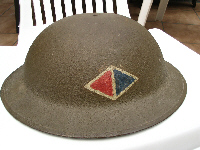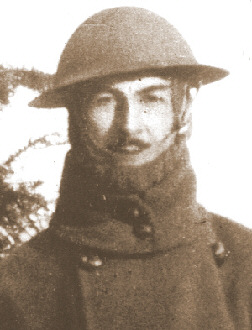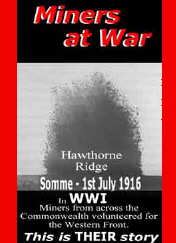
TRENCH REPORT: You've done it. I'm now receiving so many contributions [all excellent by the way] that I've been forced to expand the Trip-Wire to three full pages. Don't hold me to this, but starting in this issue time-critical material and my personal harangues will appear on Page One, special contributions on Page Two, and our regular and periodic contributors, Andy Melomet, Christina Holstein, Tony Langley, and this month, Tom Jones on Page Three. Also, this month, we will begin adding announcements about a broader range of events on our World War I Annual Calendar. . .Our far flung correspondents have sent us much: Tom Jones recommends the July issue of Military Trader which features a four page spread of WWI uniforms and kits. . .Several readers have shared that Journey's End will be returning to London's West End from the middle of September. . .David Beer sends the information that the UK's oldest man is a veteran of Jutland (link). . .The Ventura County Museum of Science and History has alerted us about their WWI Poster Show which be open through August. (link)
New at the Websites of the Great War Society and Our Friends
Click on Title to Access
|
At Great War Society Sites
At the WFA-USA
The WFA-USA Announces A New Chapter
Our Southwest Chapter Headquartered in Austin, Texas Has Begun Operation Under the Leadership of Dr. David Beer of the University of Texas
Click Here for More Information |
|
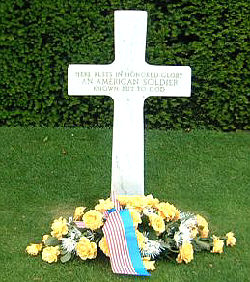
Memorial Day 2005
Congratulations are in order to our contributor Sidney Clark of the U.K. After spotting several markers of Americans in Commonwealth War Graves cemeteries, his curiosity was aroused about just how many Yanks were resting in the Commission's many plots. They responded to his inquiry with some astounding information. Over 2,800 American citizens, residents or individuals who list closest relatives in the States have been identified. Most had volunteered for service with British and Commonwealth forces before America's entry. A sub-listing of 49 members of the AEF and American volunteers was also identified. Both listings include extensive information about the individual's unit, home town, family contacts and burial location. Furthermore, Sidney was able to acquire computer files of both groups. We are developing a plan for sending this material to various depositories for researchers. To our knowledge, this list never existed before he requested it. If you have suggestions as to who might benefit from receiving these listings please contact us (link).

| This Month's
Special Feature
Shell Shock
|
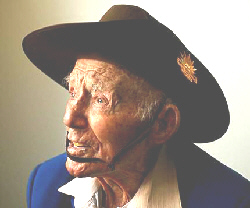
Peter Casserly, Digger
No longer can any Australian tell you with the authority of personal experience about the worst killing fields Australians have known - the slaughter yards of the western front in WWI. Peter Casserly, aged 107 who died in Perth recently was the last Australian survivor of that carnage. "I had lots of good mates but they're all gone," Mr Casserly, the last Digger to see action in France, told an interviewer last year. Mr Casserly, who transported troops and ammunition at Ypres, Armentieres and Amiens, can never shake the memory of carting young soldiers off to certain death. "They had no idea of how terrible it was," he said. (link)
 The further back you look, the further forward you can see.
The further back you look, the further forward you can see.
Winston Churchill
|

Memorable Event
|
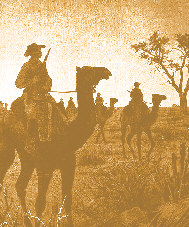
July 9, 1915
German Forces Surrender
In Southwest Africa
Click on Image for More Information
|
|

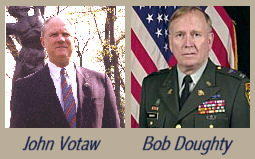
Two good friends of students of the First World War retired this past month. Both are successful authors, editors and educators who have done much to encourage study of the events of 1914-18. John Votaw is now the Executive Director Emeritus of the institution he headed for 19 years after his army career: Cantigny - The First Division Foundation at Wheaton, Illinois. His plans are to teach a bit at Dominican University in River Forest, IL; to write a bit-he is now working on a volume on commanding the 1st Division in WWI; to lead an occasional tour to the battlefields and to relax a bit with his family.
Robert Doughty, recently Chairman of the History Department at the US Military Academy, retired from the Army as a Brigadier General at the end of June after 40 years of service. At this time he is considering following his recently published book on French Strategy and Tactics in the Great War with a "prequel" about France and the origins of the war.
Besides offering a Thank-you, Well Done, on behalf of the "WWI Community" to these gentlemen, I want to add a personal note here as well. Both John and Bob have helped me with my various projects including events, articles and our websites. I deeply appreciate their support over the years, and on behalf of all of us, wish them the best in the next phase of their lives.
John Votaw's The American Expeditionary Forces In World War I can be ordered (here.)
Robert Doughty's Pyrrhic Victory : French Strategy and Operations in the Great War can be ordered (here.)

 Warning! Do Not Bite Without Dunking First!
The Anzac biscuit or cookie, particularly good for dunking, was popularized by World War I care packages to overseas soldiers of the Australian and New Zealand Army Corps. IMHO it owes its extraordinary yumminess to its coconut and maple syrup ingredients. Baked without hard-to-come-by eggs, when packed in airtight tins, an ANZAC biscuit was as good at the end of a two-month sea voyage to Europe as it was when the ship departed.
This treat can be purchased today. Some supermarket chains are starting to carry it or, if you live near a VFW post, you may be able to order a package through them. You might want to make your own: (recipe)
GREAT WAR 2005
EVENT CALENDAR
|
The Gentler Sex? Responses of the Women's Movement To the First World War
University of London
September 8-9, 2005 (link)
|
WFA-USA 16th Annual National Seminar
Virginia Military Museum [Full Program Now]
Newport News, Virginia
September 23-25, 2005 (link)
|
WFA-USA 16th Annual National Seminar
Virginia Military Museum [Full Program Now]
Newport News, Virginia
September 23-25, 2005 (link)
|
Uncovering the First World War
International Society for First World War Studies
Trinity College, Univ. of Dublin
September 23-25, 2005 (link)
|
The Red Cross at War
Great War Society Event
Armistice-Remembrance-Veterans Day
Sonoma, CaliforniaNovember 12, 2005 (email for info)
|
1915 - Innocence Slaughtered?
In Flanders Fields Museum
Ypres, Belgium
November 17-19, 2005 (program)
|
Send additions/corrections:
Email Response
|
|
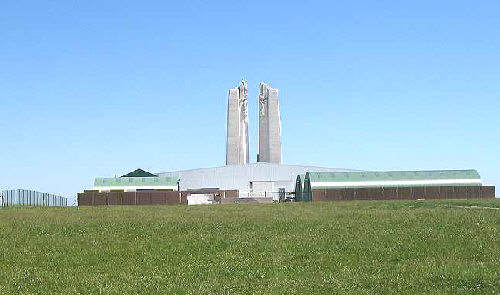
Current Restoration Work at Vimy Ridge
|
|
Page Two
|
 |
Post Your World War I Stumper Here
|
1. David Gossens in Belgium is curious about the unit patch painted on this helmet. If you recognize it please contact David directly (email)
2. Dr. Kimloan Hill at the University of California at San Diego is researching Vietnamese [Annamites] in World War I for a documentary. She is searching for more information, stories, photos about these Vietnamese and especially wants to explore their encounter with the Americans in depth. Please contact her with any information you may have (email)
|
 |
Our Family's Gold Star Pilgrimage
Part II: Gold Star Visit
Contributed by Kathy Compagno
|
Rosa Heidler Lorenz, the gold star mother in this story, is my great grandmother; the source is an excerpt from my own personal story about her life, based on documents carefully saved by her daughters Luella and Josephine. Her son Joseph fought with the 42nd Rainbow Division, was wounded at the River Ourcq, and died at a base hospital in France.
The ship America docked at Cherbourg, France, on Friday, 16 May 1930; a
welcoming committee stood at the pier waving flags of the allies, while tenders
ferried ashore the first contingent of mothers and widows ("Smiles, all
smiles!). French gold star mothers and widows welcomed their American
counterparts. The pilgrims then boarded the boat train to Paris ("On to Paris!
While French war mothers cheered and navy men stood around"), where Rosa stayed
at the Hôtel D'Iéna, located near the Trocadero one block from the Seine. She
wrote a letter home in German script and language, which was translated by her
daughter Luella,
"18 May 1930; Liebsten Kinder, Dearest children, Just a few lines to let
you know I arrived well. It was about 10 o'clock Friday evening and by the time
we were in our rooms and had a few things unpacked, it was one o'clock before we
got to bed. Yesterday morning we all met in the sitting room where they told us
everything we were going to do. In the afternoon we visited the grave of the
Unknown Soldier and from there to the hotel for tea. There were a few higher
ups there and they spoke until we returned to the hotel. It was already 6 pm.
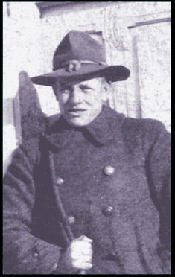
Joseph Lorenz |
"Now it is between 7 and 8 pm. This morning we went to church and in the afternoon to the Cemetery Suresnes, where Joe is buried. It is a beautiful
cemetery. But that was a little too much for one day, for I've had a headache
since I came home. I will not write much more as we are sailing again on the
29th and when I come I will be able to tell you all much better.
"Mit besten grüßen und küßen, With best wishes and kisses, from your Mother"
Rosa was given a TIME TABLE AND ITINERARY, SURESNES CEMETERY PARTY "A" GROUP No.6, from Saturday, May 17, through Wednesday, May 29. Breakfast, lunch and dinner were specified for each day, often at the hotel, other times at Belle Cycliste Restaurant Suresnes. Sightseeing trips included Versailles Palace
(Rosa noted Schloß, castle, in the margin), Napoleon's Tomb (where they saw
'some of the big guns captured from the enemy during the World War'), Chateau
Fontainebleau (with lunch at Hotel Logris), the Louvre, Notre Dame Cathedral and
Sacré Coeur. Rosa saved the map and booklet from her Visite de Paris en
Autocar, le guide officiel des autobus, tramways, bateaux. Ironically, the
guide was written in French, English, and also the German language.
Transportation was provided by 'autocar' or 'autobusses', and church services of
their choice were offered to the mothers on both Sundays. Rosa probably chose
to attend services at Saint-Joseph's English Catholic Church, where,
"The Very Reverend Gabriel MacDarby, rector, arranged a special service for 30
mothers who attended the church. Hymns were sung in English instead of Latin.
American and French flags decorated the altar. Father MacDarby chose for his
text, 'Weep but a little for the dead, for they are at rest.' "
Their first day began with an introductory conference with the 'Conducting
Officer'; after lunch, the ladies attended a ceremony at the Arc de Triomphe
with a tea reception afterwards at Restaurant Laurant. Sunday afternoon was
their first visit to the various cemeteries, where 'a wreath of fresh flowers
[was] given to each Pilgrim immediately upon arrival'. Over the next two weeks,
Rosa returned to 'the consecrated ground' at Suresnes Cemetery for seven more
visits.
Friday May 23 must have been an especially emotional day for Rosa; she visited the battlefields at Chateau Thierry and Belleau Woods, where her son Joseph had fought and been dreadfully wounded. It was a long day, with breakfast at 7 am,
departure at 9 am, and dinner at 7 pm upon their return. Refreshments were
offered in the morning and afternoon at Hotel de la Terrasso 'on the banks of
the Marne River', while they had lunch at Chateau Thierry's Hotellerie du
Bonhomme. The afternoon included visits to Aisne-Marne Cemetery at Belleau.
Sadly, Rosa penciled a note on her itinerary, 'ich >>> Tod >>> Sohn', the death
of my son. One newspaper had a photo of another group visiting Verdun, with the
caption, "Some of their sons lost their lives near this famous 'bayonet trench'
at Verdun, so these American Gold Star mothers are picking flowers from the soil
that once was damp with blood of heroes." A cluster of faded green clover
leaves was found amongst Rosa's souvenirs from her pilgrimage.
French and American newspaper articles followed every step of the pilgrimage.
The family saved articles about the journey from Chicago, New York, Dayton and
Parisian newspapers. "MOTHER LOVE: Before visiting graves of sons in France,
first contingent of American Gold Star mothers laid wreaths on tomb of France's
unknown soldier at Arc de Triomphe." Several tell about Rosa's visit to the
cemetery at Suresnes, and many included her photograph. She was amongst a group
pictured on the front page of the Parisian Excelsior,
"LES MERES ET VEUVES AMERICAINES AU CIMETIERE DE SURESNES"
(AMERICAN MOTHERS AND WIDOWS AT SURESNES CEMETERY)
Our Rosa shared the front page with General John J. Pershing, who paid his
respects at nearby Belleau Wood Cemetery that same day. Another photo (by
Pacific and Atlantic Photo) of our Rosa Lorenz captured the poignancy of this
pilgrimage and the attention of many newspapers. We see Rosa kneeling by her
son's white cross at Suresnes, with her face hidden behind her hands. Rows of
other crosses are seen in the background; her wreath of spring flowers decorates
Joe's grave. New York's 'picture newspaper', Daily News, used Rosa's photograph
on the front page for Wednesday, 28 May 1930; the caption said,
"Alone among the crosses, her knees bent before the plain white marker that
stands above the grave of her hero son, Joseph Lorenz, a private in the 42nd
Division, his mother weeps. . . and wonders. . . and prays. Time is short. She
must go. But her wreath will guard her son."
Dayton Daily News eloquently described their first view of the cemetery,
"On and on the crosses stretch. . . all white and clean. . . all of them alike
in looks. . .all of them alike in their message. At her journey's destination,
[each mother] comes to her son's grave in the Suresnes Cemetery just outside of
gay Paris where the boys of the A.E.F. were wont to get a few snatches of
pleasure 'mid the horrors of war."
The European edition of the New York Tribune continued the story,
Sixteen Gold Star Mothers Lay Wreaths
On Graves Of Sons In Suresnes Cemetery
"Every one of the 1,534 white marble crosses which stand overlooking Suresnes
was scrubbed and polished and glistening white for the first visit of the Gold
Star Mothers who have been sent by the government to see their loved one's
graves. Yesterday was one of the proudest moments in the eight years' service
which James A. Duncan, superintendent of the Suresnes American Military
Cemetery, has devoted to the care of the graves.
"Seventeen wreaths of roses, carnations and asters, tied with bits of red,
white and blue ribbon, were spread on the lawn beneath the flag, awaiting the
mothers as they came up the steps and through the gate. Captain W. A. Dalton
explained that the wreaths were a gift from the government so that every mother
would have the same decorations for her son's grave. They chose the ones they
wished and with a silent attendant were taken along the rows of white crosses
and left alone before the graves of their sons. . . Their tears were more of
consolation than of grief. One mother said, "It is such a comfort to know that
he rests in such a beautiful place. I've seen it many times in moving pictures
and have stayed to see the reels twice, but I didn't realize it was so beautiful
with these hawthorne trees, catalpa, judas and laburnum shrubs. I'm so grateful
to these dear men who take such good care of the graves. . . I am more than
consoled to find the cemetery so lovely with its clean, smooth lawns and trees.
I thought they still had wooden crosses. It is all so much nicer than I
expected to find it."
"They also placed wreaths on the six graves with crosses whose inscriptions
are, "Here rests in honored glory an American soldier unknown but to God." The
mothers rested a few minutes in the reception room, were told some of the
history of the cemetery and signed the guest book before departing. They will
revisit the cemetery today and make daily trips to Suresnes during their stay in
France."
Liberty Magazine published a five-page article about the pilgrimage in the 19
July 1930 issue, titled "Mothers Remember; an Account of the Gold Star
Pilgrimage to American Cemeteries in France". Once again, our Rosa's photo at
Joe's grave in Suresnes graced the story. Her daughter Luella was amazed; "Was
surprised to see Mom's picture and alone! kneeling at Joe's grave, as she was
never one to push herself into the limelight." The author, Grace Robinson,
sailed on the America with Rosa and the first group of pilgrims.
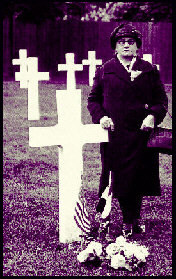
|
We have a professional black and white photograph of Rosa solemnly standing by
her son's grave; her hand rests protectively on his cross.
JOSEPH LORENZ
PVT. 1 CL, 150 M. G. BATT'N, 42 DIV.
WISCONSIN NOV. 21, 1918
On Thursday, May 29, Rosa took the 'boat train' to Cherbourg, and returned to
New York City in Cabin C-11 on the United States liner President Harding. Her
scrapbook preserved a SOUVENIR LOG, Capt. J. L. Beebe, Commander, U.S.N.R.
Distance traveled from Cherbourg Breakwater to Ambrose Channel Lightvessel was
3162 miles, with a passage of 7 Days, 10 Hours, 20 Minutes averaging 17.7 Knots
in speed. Joined by her daughter Josephine, Rosa stayed a few weeks with Luella
in New York City before continuing on to Dayton. Rosa was interviewed "at the
Brooklyn home of her married daughter, Mrs. Alfred Oelridge [sic]," by the New
York World for publication in The Dayton Daily News, as the "first of the
Dayton contingent to return to these shores",
Dayton War Mother Finds Joy and Sorrow in France
"A cheery little lady of just past middle age who came to this country from
Austria only to raise a son who was called upon to fight for her fatherland,
Mrs. Lorenz said today that her pilgrimage was one of mingled 'joy and sorrow.'
But in spite of the solemnity of visiting her boy's grave, she now has the
satisfaction of having seen the places where he fought valiantly, died and was
buried. And she is exceedingly grateful to the government for having given her
the opportunity and for the care with which the government keeps up our
cemeteries in France.
"Mrs. Lorenz said that the officials of both the United States and French
governments had done everything within their power to make the Gold Star
Pilgrimage a happy one. She was particularly impressed with the ovation given
the group when it arrived on French soil at Cherbourg after a pleasant ocean
crossing of ten days. Bands, cheers and speeches greeted them as they
disembarked from the tender. Given official courtesy, they were sped through
the usually rigorous French customs inspection and started immediately for
Paris, where they spent most of the following two weeks.
"In Paris the group was divided into smaller groups, according to the
cemeteries which each was to visit. Mrs. Lorenz and 18 others were guests at
Hotel D'Iena. The group made almost daily visits to Suresnes, where the
government furnished wreaths and fresh flowers for each mother and widow to put
on the grave of her son or husband as the case might be. Suresnes, Mrs. Lorenz
said, was kept in beautiful condition by a large crew of caretakers. Countless
rows of marble stones, marking the graves beneath, rise from level turf so well
kept as to look like green velvet. A beautiful stone chapel is just being
completed.
"When the groups were not at the cemeteries, they were taken about Paris and
the battlefields on sightseeing tours in huge buses. Mrs. Lorenz visited
Chateau Thierry and Belleau Woods [Rosa told the interviewer that her Joe was
wounded in action in Belleau Woods on 2 August 1918], and the trenches and
dugouts still intact in these places, made her realize vividly what her son had
been through.
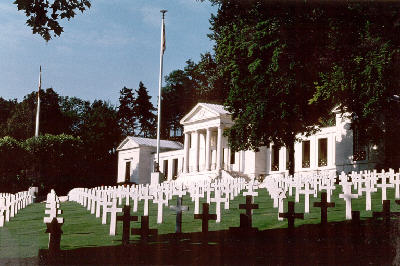
Suresnes Cemetery Where Joseph Rests Today
"In Paris she attended ceremonies at the Tomb of the Unknown Soldier and the
Cathedral of Sacre Couer. She also visited Notre Dame, Versailles, the Louvre,
and Napoleon's Tomb. At many teas and luncheons, the group was fêted by high
French and American officials, including General Pershing.
"Although in the center of things and styles feminine, Mrs. Lorenz said she
spent very little time in actual shopping, although she smilingly admitted
accompanying several others on their buying expeditions in the French shops.
"I am glad to be home again," she said in conclusion. "It has been a wonderful
trip. I am feeling fine and I made many friends among the other Gold Star
mothers. I am sorry that I had no opportunity to visit my old home in Austria,
but time was too short. And I want to emphasize my appreciation of the courtesy
and hospitality that was shown to all of us everywhere we went."
After several weeks visiting Luella in New York City, Rosa and Josephine
returned to Dayton. Rosa remained active with the Gold Star mothers, and kept in touch with those
she had met on her Pilgrimage, saving one of their Christmas Greetings,
"My dear little Mrs. Lorentz, Your Christmas card with its kindly wish and
greeting reached me to day. It did me so much good to hear from you who shared
our cabin both going and coming when on our wonderful trip across. The year
1930 was good to us and we shall never forget it. . . You were always so jolly
and full of fun during both voyages, it helped [me] a lot. Especially on return
voyage. I never eat soup but think of the evening on the President Harding that
you began to tell us what good soup you had-- the result you no doubt remember.
[If only we knew the story!!] Our 'Sun bonnet woman' Mrs. Mattox only lived two
weeks after she returned from France. How did she make that trip when in such a
state health. Should you ever get to Newark please come and see me. . .
Your friend of the Pilgrimage,
Mary E. Swingle"
Kathy Compagno is the sister-in-law of Great War Society President Sal Compagno.
|
|
Page Three
|
From Tony Langley's War in a Different Light
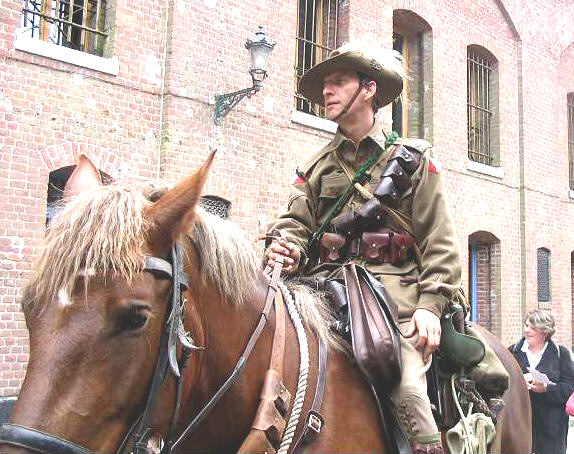
Recent Australian Light Horse Sighting
May 22, 2005 Re enactor's Event Fort Seclin, Near Lille, France
Click Here to Visit War in a Different Light
|
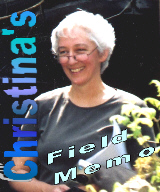 |
New Monument Near Verdun
By Christina Holstein
|
This monument just to the east of Verdun on the Woevre plain. It was inaugurated earlier this year on the 90th anniversary of Louis Pergaud's death on 8 April 1915. Pergaud was born in 1882. He wrote lively and amusing works about country people and animals and received the Prix Goncourt in 1910 for his best-known work, "La guerre des boutons", which was made into a film in 1962. During the night of 7-8 April 1915, Pergaud led his men into attack on Hill 233 close to Marchéville and disappeared. The monument is on the D 904 road. Take the D 903 out of Verdun in the direction of Fresnes-en-Woevre. At the road fork to the west of Fresnes, take the D 904 towards Marchéville. One kilometer before Marchéville, take a left fork on the D 113 to Saulx-les-Champlon. The Pergaud monument is to be seen on the left about 200 mtrs beyond the fork. There is a small parking area on the D 904 just before the fork and another area where a car can pull in just opposite the monument.
|
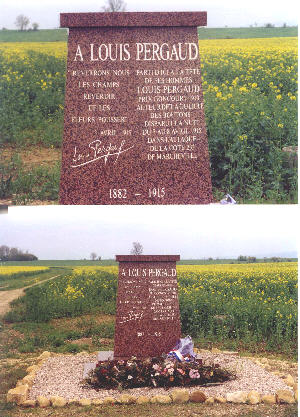 |
|
 |
Notable Hoosiers in the Great War
Contributed by Major General Thomas Jones
|
This month starts a new contribution from member Thomas Jones of Indiana. He has gathered information on notable "Hoosiers" who served in the Great War. Every few months we will be feature a new profile.
Robert H. Tyndall (1877-1947) was commander of the 1st Indiana Field Artillery in 1917 when it was called to active duty, redesignated the 150th Field Artillery Regiment and assigned to the 42nd Rainbow Division. Colonel Tyndall had seen his first military service in the Spanish American War in Puerto Rico. In France, his unit fought in all the actions of the Rainbow Division including: the Vosges, Baccarat, Lunneville, Dombasle, Champagne, Aisne-Marne, St. Mihiel and the Argonne. Colonel Tyndell received the Distinguished Service Medal for "his high technical attainments, his untiring energy and devotion to duty." Afterwards he was the first national treasurer of the American Legion. He retired from military service in 1941 as a Major General and was later elected Mayor of Indianapolis. Sadly, he died in office in 1947.
|
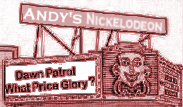 |
MINERS AT WAR
By Andrew Melomet
|
Miners At War tells the stories of the men from mining communities across the British Empire who volunteered for military service in the Great War.
The use of "sappers" to dig tunnels under your enemy's trenches and then exploding a charge to create a breach is an old technique. Fans of the board game "Stratego" based on 19th century warfare will recall it included both "bombs" and "miners" among the playing pieces. In the First World War, the Germans were the first to successfully use mines against the Allies in December 1914 when they blew up an entire Indian Brigade on the Western Front in Belgium.
A surplus of coal and the expected shortness of the war made the prewar work force seem too large. So, at the start of the war, economic conditions were such that the mine owners eagerly gave up their experienced workers. Among the British miners who volunteered, if they were the right size they were accepted immediately. Those that were too short and too small were initially rejected but later formed "Bantam" Battalions
The first mining sections were made up of men with no mining experience, tools or listening equipment to enable them to learn where the German tunnels were. By February 1915, specialized tunneling companies were formed, made up largely of coal miners. From then on the miners made contributions at Hooge Château, the Somme, Passchendaele and especially the devastating mine attack at Messines.
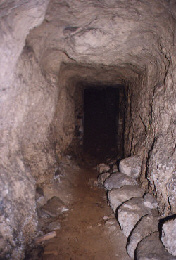
Tunnel in Aisne Sector |
Produced by John Mason and Hilary St. John, Miners At War offers a basic introduction to World War I as well as the stories of Allied miners on the Western Front and Gallipoli. It blends archival photographs and film footage with contemporary scenes, rather reminiscent of the "Then and Now" photographs in After The Battle Magazine. It uses the poignant songs of the era as well as modern music to great effect.
I was touched by the anecdote of how the Scots miners who spoke Gaelic gladly "adopted" the South African miners who spoke Afrikaans. It brought back the child hood memory of living in Duryea, Pennsylvania, known as the "Babylon" of Pennsylvania for the great variety of languages spoken by the miners from many European nations who lived there. In the great Anthracite coal fields of the Northeast, it was entirely possible to have next door neighbors who couldn't speak to each other, knowing only the international language of the brotherhood of coal mining.
When America entered the war, the Pennsylvania miners served in the 28th Division, but as regular soldiers not specialized miners. The division patch, a red keystone, gave the division the name of the "Bloody Bucket." My wife, Diane Rooney, is involved in getting American coal miners honored with a commemorative stamp. For further information go to: http://www.coalminerstamp.com/
Miners At War is available from the producers at: http://www.puddleproductions.co.uk. If you have an interest in this specialized art of warfare, I recommend it.
Andrew Melomet, Proprietor of Andy's Nickelodeon will answer your Great War film or video inquiry. He is also soliciting your recommendations for the WWI Filmography he is compiling for our readers. Just click HERE.
|
|
| The following are thanked for their contributions to this issue of the Trip Wire: Steve Gehnrich, Tom Jones, David Beer, Christina Holstein, Kathy Compagno, Tony Langley, Susan Neeson, Andy Melomet, Len Shurtleff and the Sydney Morning News for Peter Casserly's photo. Until next month, your editor, Mike Hanlon. |
|















